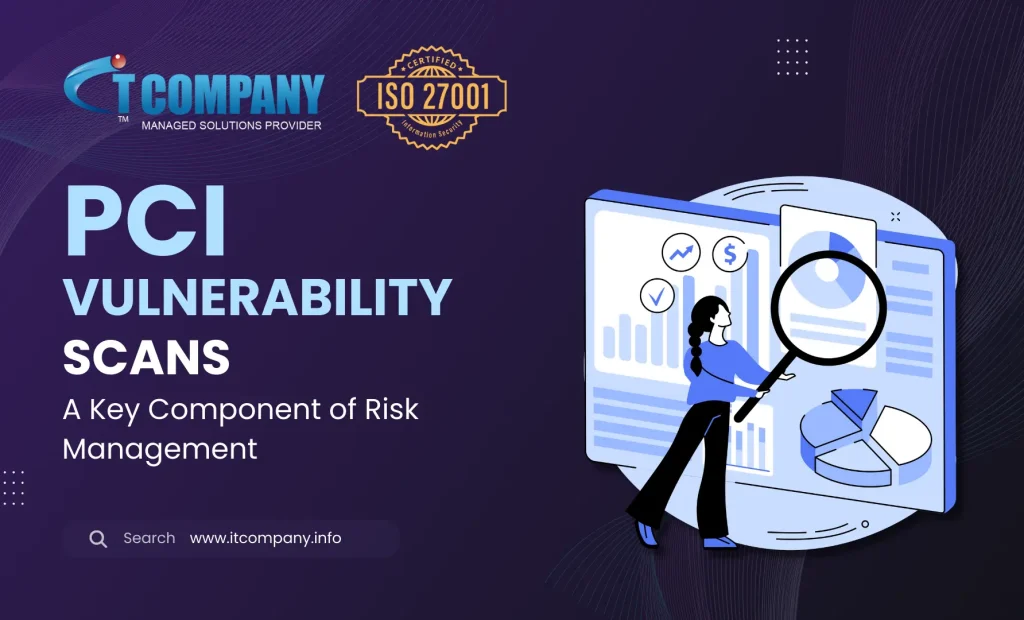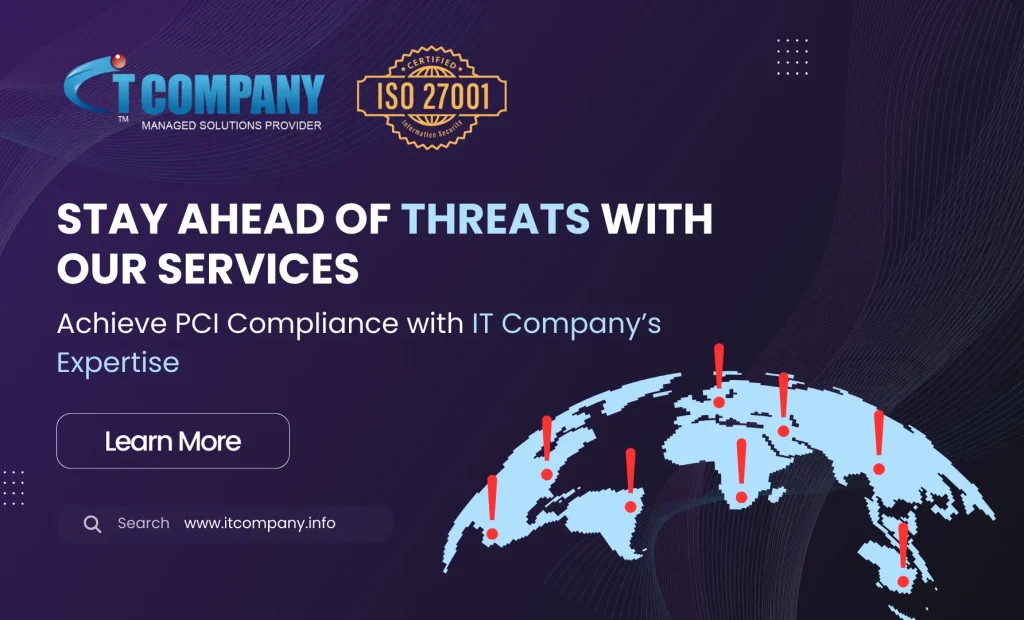
PCI vulnerability scans are a cornerstone of effective cybersecurity, safeguarding your digital assets and strengthening your security measures. IT Company, ISO 27001 certified, excels in delivering top-notch scanning services.
Remember, businesses of all sizes face digital threats at any time and from anywhere. Understanding the role of scans in PCI DSS (Payment Card Industry Data Security Standard) compliance is crucial for robust risk management.
Table of Contents
ToggleUnderstanding PCI Vulnerability Scans
| Type of PCI Vulnerability Scan | Description | Focus Areas |
| External Vulnerability Scans | Assess the security of systems visible to the internet. | Web servers, firewalls, and other internet-facing systems. |
| Internal Vulnerability Scans | Focus on internal network systems to detect vulnerabilities within the organization. | Servers, workstations, internal network devices. |
| Web Application Scans | Target web applications to identify application-specific vulnerabilities. | SQL injection, phishing attacks (XSS), and other web app issues. |
| Network Scans | Analyze network configurations and devices for security weaknesses. | Open ports, insecure protocols, network security. |
| Configuration Scans | Examine system configurations and settings for misconfigurations and insecure defaults. | System settings, configuration errors. |
| Database Scans | Focus on database systems to identify vulnerabilities related to database security. | Authentication mechanisms, data storage practices. |
| Wireless Network Scans | Detect vulnerabilities in wireless networks, including encryption and unauthorized access points. | Wireless encryption, rogue access points. |
Fact Sheet: PCI Vulnerability Scans and PCI DSS Compliance
1. Purpose of PCI Vulnerability Scans
- Identify Vulnerabilities: The primary role is to detect and assess security weaknesses that can create loopholes. And attackers can exploit vulnerabilities.
- Enhance Security: Address vulnerabilities to protect cardholder data and ensure overall system security, so that data will be secured.
- Ensure Compliance: Meet PCI DSS requirements by regularly conducting scans to maintain a secure environment.
2. Key Requirements under PCI DSS Related to Vulnerability Scanning
| Requirement | Description |
| Requirement 11.2 | Regular Vulnerability Scanning: Conduct internal and external vulnerability scans at least quarterly and after any significant changes to the network to secure website from hacking. |
| Requirement 11.2.1 | Approved Scanning Vendor (ASV): Use an ASV for external vulnerability scans to ensure compliance with PCI DSS. |
| Requirement 11.2.2 | Scan Results: Ensure that scan results are reviewed, documented, and that identified vulnerabilities are addressed and mitigated. |
| Requirement 11.2.3 | Penetration Testing: In addition to regular scans, perform penetration testing to evaluate the effectiveness of security measures. |
| Requirement 6.1 | Patch Management: Ensure that vulnerabilities identified through scans are addressed promptly with appropriate patches or mitigations. |
| Requirement 11.3 | Internal Network Scanning: Conduct internal network scans to detect vulnerabilities within the organization’s network. |
3. Key Components of PCI Vulnerability Scans
- External Scans: Identify vulnerabilities in systems exposed to the internet.
- Internal Scans: Assess internal network systems for potential security weaknesses.
- Web Application Scans: Focus on vulnerabilities specific to web applications.
- Configuration Scans: Check system settings and configurations for security flaws.
4. Compliance Monitoring and Reporting
Maintaining comprehensive documentation of vulnerability scans is crucial for PCI DSS compliance, effective remediation efforts, and enhanced protection of assets. Regular review of scan results ensures continuous improvement in security measures.
This practice facilitates the prompt identification and mitigation of vulnerabilities. A robust security posture to potential investors and customers, building trust and confidence.
5. Role of IT Company in Compliance
- Expertise: We have team of experts specialized in conducting and interpreting sans to ensure compliance and meet clients’ expectations.
- Certified Tools: We use certified methodologies and tools to perform accurate and most reliable scans.
- Ongoing Support: We offer continuous support to address vulnerabilities and maintain compliance.

How Scans Help in Discovering Potential Security Weaknesses
It helps in analyzing systems and networks to identify security weaknesses, such as outdated software, misconfigurations, and exposed ports.
These scans use automated tools to detect potential entry points that could be exploited by attackers, providing a detailed inventory of vulnerabilities that need to be addressed.
Prioritizing Risks
After identifying vulnerabilities, assessing their severity and potential impact is crucial. Risks are prioritized based on exploitability, the criticality of the affected systems, and the potential damage.
High-severity vulnerabilities that could lead to significant data breaches or system compromise are addressed first, ensuring that the most critical issues are managed effectively.
Mitigation Strategies
Mitigation involves taking specific actions to resolve or reduce the impact of identified vulnerabilities. This may include applying patches, reconfiguring systems, enhancing security protocols, or removing unnecessary services. A structured approach to remediation ensures that vulnerabilities are addressed systematically and effectively.
Regular scans are essential for ongoing security maintenance. Continuous monitoring helps detect new vulnerabilities that may arise from system changes, software updates, or evolving threats. By conducting scans on a regular basis, organizations can ensure that their security measures remain effective and adapt to emerging risks, maintaining a strong defense against potential attacks.
Challenges and Solutions
Technical and Operational Challenges
- Complexity of IT Environments: Modern IT environments are often complex, with numerous interconnected systems, applications, and devices. This complexity can make it difficult to conduct comprehensive scans and accurately identify vulnerabilities.
- False Positives and Negatives: Vulnerability scans may produce false positives (incorrectly identifying a non-issue as a vulnerability) or false negatives (failing to detect actual vulnerabilities), which can complicate the remediation process.
- System Performance Impact: Scanning processes can affect system performance, causing slowdowns or disruptions in critical operations. Utilize it in large or sensitive environments.
- Resource Constraints: Limited personnel or expertise can hinder the effective management of vulnerability scans, from performing the scans to analyzing results and implementing remediation measures.
- Integration Issues: Integrating vulnerability scanning tools with other security systems and processes can be challenging. Compatibility issues or tools that are not well-suited to the organization’s specific environment may contribute to the difficulty.
Solutions and Recommendations
- Simplify and Segment IT Environments: Where possible, break down complex environments into smaller, manageable segments. This approach can make it easier to scan and manage individual components without overwhelming the system from IT services perspective.
- Implement Advanced Scanning Tools: Use advanced vulnerability scanning tools that incorporate machine learning and improved algorithms to reduce false positives and negatives. Regularly update these tools to stay current with emerging threats.
- Schedule Scans Wisely: Conduct scans during off-peak hours, as it does not impact the performance. This minimizes the impact on performance. Utilize scanning tools that offer options to perform less intrusive scans or have minimal performance overhead.
- Allocate Resources Effectively: Invest in training for IT staff to enhance their skills in vulnerability management. Consider engaging with third-party security experts or consultants if internal resources are insufficient.
- Ensure Tool Compatibility and Integration: Select scanning tools that are compatible with your existing security infrastructure and can integrate seamlessly with other systems.
- Regular Updates and Maintenance: Keep your vulnerability scanning tools and processes updated with the latest threat intelligence and best practices to ensure they remain effective and relevant.
- Develop a Comprehensive Remediation Plan: Create a clear and structured plan for addressing vulnerabilities, including prioritization based on risk, assigning responsibilities, and tracking progress.
With targeted strategies and solutions helps organizations enhance the effectiveness of their PCI vulnerability scans.
Targeted strategies and solutions helps organizations enhance the effectiveness of PCI vulnerability scans.
Future Outlook
The future of PCI vulnerability scanning is marked by rapid technological advancements and evolving threat landscapes. Emerging trends include the integration of artificial intelligence and machine learning to improve scan accuracy and reduce false positives.
Automated and continuous scanning solutions are becoming more prevalent, enabling real-time vulnerability detection and response.
The complexity of IT environments grows, there will be a greater emphasis on adaptive scanning techniques and comprehensive threat intelligence to stay ahead of sophisticated cyber threats.
Conclusion
It is essential for identifying and addressing security weaknesses in an organization’s IT environment. They play a crucial role in meeting PCI DSS compliance requirements, protecting sensitive data, and mitigating potential security threats.
Regular vulnerability scanning helps organizations detect vulnerabilities early, prioritize risks based on their severity, and implement effective remediation strategies. Overall risk management and safeguards against potential data breaches.




